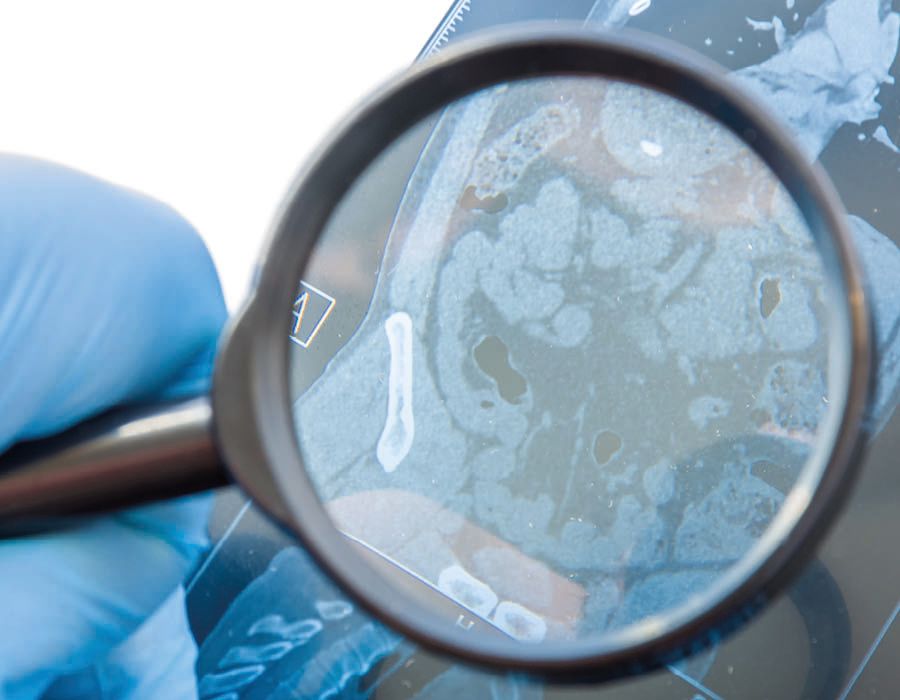Quality
of care
We look at two studies evaluated using NCEPOD tools


Martin Sinclair:
NCEPOD Clinical Coordinator and Consultant Upper GI Surgeon
Surgeons can evaluate and enhance services using National Confidential Enquiry into Patient Outcome and Death (NCEPOD) tools. For 35 years NCEPOD has conducted quality improvement studies. This update highlights two surgically relevant studies involving patients with testicular torsion or Crohn’s disease.
MAKING THE CUT
A review of the care received by patients undergoing surgery for Crohn’s disease.
By John Abercrombie and Simon McPherson
Over 50% of patients with Crohn’s disease develop complications and 70–90% will eventually need surgery. This study assessed care provided to patients aged 16 and over who underwent surgery. Data were collected using questionnaires from 553 clinicians, 414 sets of case notes and 138 organisations. The key findings from the report are the need for holistic support, improved medication management, timely recognition of when surgery is beneficial, and effective handover and joint care with the gastroenterology team after surgery.
Consider surgery as a potential treatment option for patients with Crohn’s disease
Surgery is often seen as a failure in Crohn’s disease management, but should be a vital treatment option. A total of 18.8% of patients should have been referred earlier for a colorectal surgical opinion. And 20.1% encountered more than one delay in elective surgery, with 14 patients having adverse outcomes. Patients should be referred early for surgical consideration when medication alone is not sufficient.
Make sure the handover of care from the surgical team to the medical team is robust
After surgery, 54.1% of patients did not see a gastroenterologist or an IBD nurse. Medication adjustments might be necessary to lower the risk of immunosuppression following surgery, but only 46.7% of patients had a pharmacist involved. There should be a plan for postoperative discharge of patients including:
• Handover of care to the inflammatory bowel disease/gastroenterology team who will look after the patient’s ongoing medical care.
• Undertaking a medication review.
• Providing information to the patient on who to contact in the event of an emergency.
• Providing information to the patient on pain management, including what can be taken, not just what to avoid.
• Booking follow-up appointments.
• Providing information to the patient on how to access psychological support if needed.
• Communicating all of the above to the patient and their GP.
Provide holistic support for all patients with Crohn’s disease
Psychological support was available in 9% of cases and 38.9% of patients had their nutritional status assessed before surgery. However, 42.6% of patients desired psychological support and 34.8% dietetic support, highlighting the need for holistic care for all Crohn’s disease patients.
Medication should be managed effectively at all stages of the pathway
A total of 61.1% of patients were taking medications for their Crohn’s disease, with side effects in 15%. And 20.3% needed improvement in medication management. You should optimise medications for patients with Crohn’s disease including review of:
• Prescription and/or discontinuation of steroids, biologicals, immunomodulators.
• Steroids – bone protection, PPIs.
• Steroid treatment card >3 weeks.
• Pre-op medication review – decision to operate.
• Avoid 5-ASA for treatment of Crohn’s.

Perform surgery promptly once a decision to operate has been made
A total of 42.5% of patients waited more than 18 weeks for surgery, while 10% waited over six months. Up to 13% of hospitals reported targets for scheduling Crohn’s surgery. And 12.6% of patients awaiting elective procedures underwent emergency surgery.
Patients with Crohn’s disease should have surgery within one month of the decision to operate. This would prevent elective patients becoming emergencies. An investigation should be conducted when a patient with Crohn’s disease on an elective surgery waiting list undergoes emergency surgery for a complication of their Crohn’s disease.
TWIST AND SHOUT
A review of the pathway and quality of care provided to children and young people aged two to 24 years who presented to hospital with testicular torsion.
By Antony Michalski and Martin Sinclair
Testicular torsion is a surgical emergency requiring prompt diagnosis and intervention to preserve the testicle. A review of the care provided to patients aged two to 24 years was conducted using 574 clinician questionnaires, 143 organisational questionnaires and 635 case notes. The study aimed to understand the pathway and quality of care in this condition. Key findings from this study are related to awareness of the condition, early recognition and surgery, and follow-up arrangements.
Increase public awareness
Despite 73% of patients contacting a healthcare provider within six hours of symptoms, 34.7% of parents/caregivers and 65.7% of patients do not recognise testicular torsion before admission. It is critical to spread awareness and get to an emergency department straightaway. An extended public awareness campaign is needed for all who may be affected, including parents/carers and raised at all stages of development from birth to higher education.

Ensure pathways minimise the need for transfers
A total of 12.6% of patients were referred by their GP, 7.2% from urgent treatment centres and 5.3% via NHS 111 - If patients were on a pathway only 23.9% had testicle removal compared with 39.6% not on a pathway. Pathways need to be developed for patients up to and including arrival to hospital to reduce delays for patients with testicular pain/suspected testicular torsion by:
• Minimising transfers to another hospital by referring patients to a hospital where scrotal exploration can be performed safely on site – ideally including a pre-alert to the receiving hospital.
• Ensuring any essential transfer is as urgent as possible, including when patients self-present but need to be at another hospital.
• Having a clear, documented clinical pathway of care for patients with testicular pain/suspected testicular torsion in hospitals where surgery for testicular torsion is undertaken, which is communicated to all healthcare professionals involved in the care of this group of patients.
• Auditing the testicular torsion pathway, at least annually, to identify areas for improvement.
• These measures will minimise the need for transfer and reduce the risk of delay to theatre.
Extended follow-up
Follow-up is crucial for patients considering prosthetic testicular replacement, checking for delayed atrophy and discussing fertility. A total of 26% of orchidectomy patients had information on prosthetic replacements with explanation recorded in 59.7%, and 52.8% of patients had adequate written discharge information.
Discharge information for patients and parent/carers should include:
• Any follow-up arrangements.
• Delayed side effects that might occur following orchidectomy, or the risk of late testicular atrophy in patients who had orchidopexy, including risks to fertility.
• Details of patient-initiated follow-up – for example, to discuss prosthetic implants and how to access psychological support.
• How to access psychological support.
Urgent senior review, decision-making and operation
A total of 31.3% of patients had their first assessment performed by a junior trainee upon arrival, while 26.8% did not receive their first ST3+ surgical review within two hours and 9.5% waited over four hours. Delays in diagnosis affected 18.3% of patients, impacting care in 59.5% of those. To ensure prompt treatment, patients with suspected testicular torsion should have an urgent referral and clinical review by a senior surgical decision-maker (minimum ST3 or equivalent) specialising in urology, paediatric surgery or general surgery.
ACTION
For further information including free audit and QI tools click here

